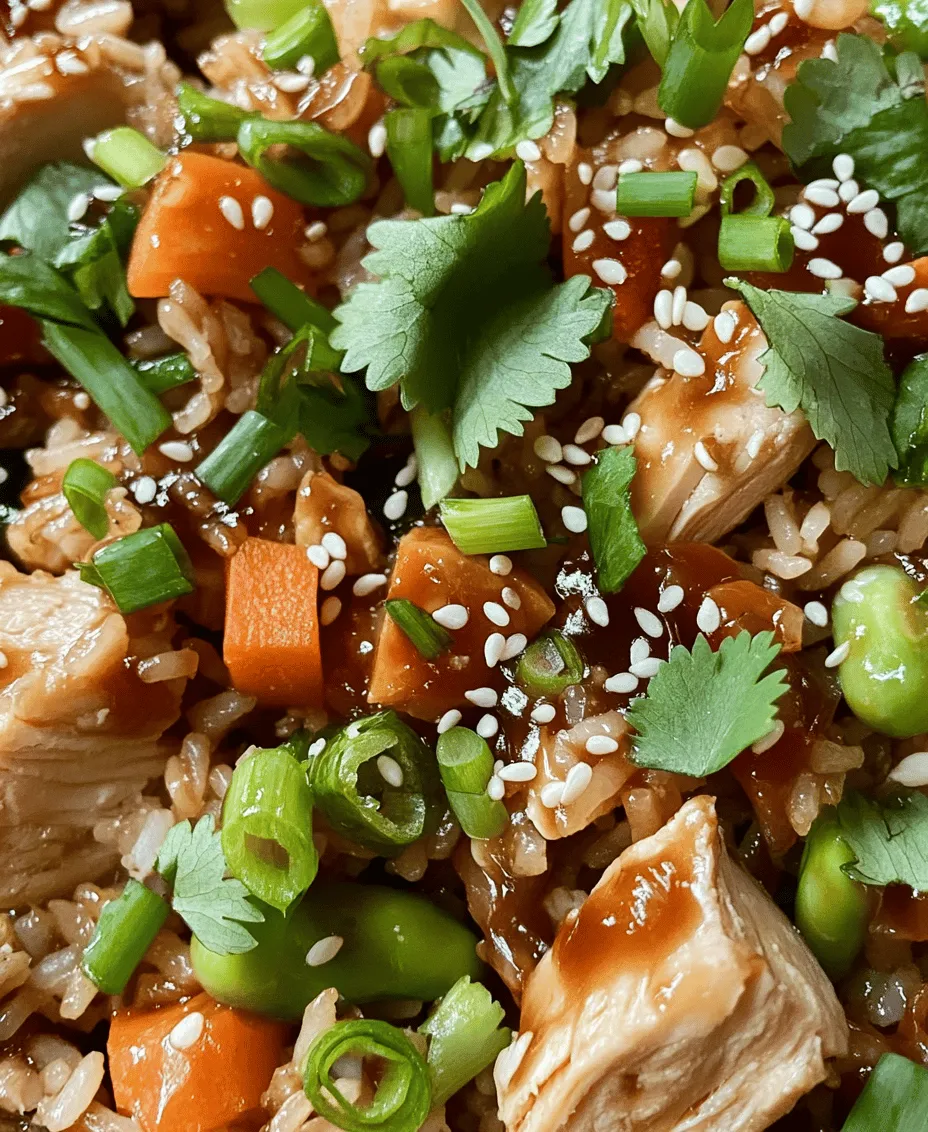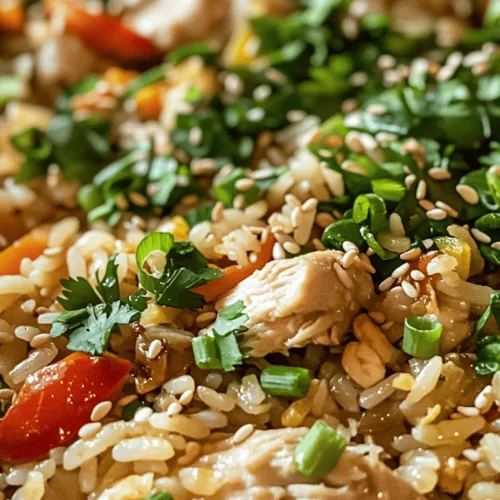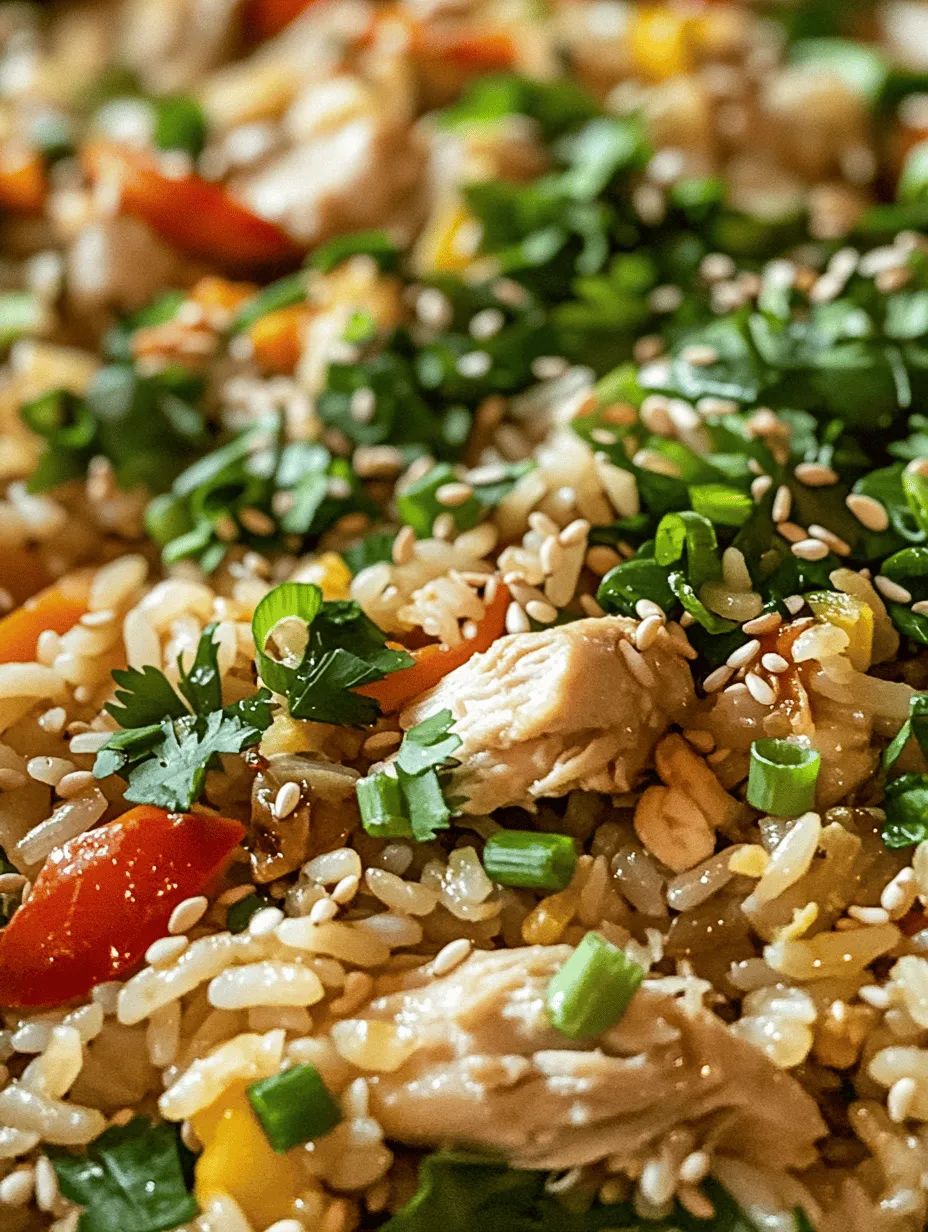Introduction
Welcome to the world of culinary fusion where comforting fried rice meets the rich, savory flavors of Japanese BBQ! The Savory Japanese BBQ Chicken Fried Rice Extravaganza is a delightful dish that brings together the best of both worlds. Imagine tender pieces of marinated chicken thighs, vibrant vegetables, and perfectly cooked rice all infused with the unmistakable taste of soy and teriyaki sauce. This dish not only satisfies your hunger but also offers a journey through the rich landscape of Japanese cuisine.
Fried rice, a beloved staple in many Asian cultures, holds a special place in Japanese culinary traditions. Known as “chahan,” fried rice is often served as a quick meal or a side dish. It reflects the essence of resourcefulness—transforming leftover rice into a flavorful feast that can be customized to suit any palate. In this recipe, we emphasize the importance of using day-old rice, as it plays a crucial role in achieving the ideal texture and flavor. Freshly cooked rice tends to be too moist and sticky, which can lead to clumpy fried rice. Day-old rice, on the other hand, dries out slightly, allowing each grain to remain distinct and absorb the rich flavors of the dish.
Understanding the Key Ingredients
To create a truly memorable Savory Japanese BBQ Chicken Fried Rice, it’s essential to select the right ingredients. Each component contributes to the overall flavor profile, ensuring that every bite is packed with deliciousness.
Jasmine Rice
When it comes to fried rice, choosing the right type of rice is paramount. Jasmine rice, with its slightly floral aroma and fluffy texture, is the preferred choice for this dish. Its long grains separate easily during cooking, allowing for a light and airy fried rice. However, the key to achieving that perfect texture lies in using day-old jasmine rice. Refrigerating the rice overnight not only helps it firm up but also makes it easier to fry without becoming mushy. If you find yourself short on time, you can also spread freshly cooked rice on a baking sheet to cool it quickly before using it in the recipe.
Chicken Thighs
For the protein component of this dish, chicken thighs are the star of the show. Unlike chicken breasts, which can dry out easily, thighs are juicy and tender, making them ideal for marinating and frying. Marinating the chicken in a mixture of soy sauce, teriyaki sauce, and sesame oil enhances its flavor while also helping to tenderize the meat. The marination process allows the chicken to absorb the savory notes, resulting in a rich and flavorful base for our fried rice. Aim to marinate the chicken for at least 30 minutes, but for best results, let it sit for a few hours or overnight.
Flavor Enhancers
The unique flavor profile of Savory Japanese BBQ Chicken Fried Rice comes from a combination of key ingredients that are staples in Japanese cooking.
– Soy Sauce and Teriyaki Sauce: Both of these sauces play pivotal roles in adding depth and umami to the dish. Soy sauce provides a salty, savory flavor, while teriyaki sauce introduces a hint of sweetness and richness. Together, they create a harmonious balance that elevates the overall taste of the fried rice.
– Sesame Oil: This fragrant oil is a cornerstone of Japanese cuisine and adds a distinct nutty flavor to the dish. By incorporating sesame oil into the cooking process, you’re not only enhancing the taste but also infusing the fried rice with the essence of traditional Japanese cooking.
– Mirin: Although optional, mirin can be a remarkable addition to your fried rice. This sweet rice wine adds a depth of flavor that complements the savory elements of soy and teriyaki sauce. If you choose to include mirin, you can reduce the amount of sugar in your teriyaki sauce to achieve the perfect balance.
Vegetables
Adding mixed vegetables not only boosts the nutritional value of your fried rice but also brings a pop of color and texture to the dish. Peas, carrots, bell peppers, and green onions are popular choices that provide a delightful crunch and freshness. Feel free to substitute with your favorite vegetables or whatever you have on hand. Broccoli, snap peas, or even corn can work well to add different textures and flavors.
Preparation Steps Explained
Now that we’ve explored the essential ingredients that make up the Savory Japanese BBQ Chicken Fried Rice, it’s time to delve into the preparation steps. This part of the process is crucial for achieving a delicious and satisfying dish.
Marinating the Chicken
The first step in preparing your fried rice is marinating the chicken. This process is essential for enhancing both flavor and tenderness. Start by cutting your chicken thighs into bite-sized pieces. In a bowl, combine soy sauce, teriyaki sauce, sesame oil, and any additional seasonings you prefer, such as minced garlic or grated ginger. Add the chicken pieces to the marinade, ensuring they are well-coated. Cover the bowl and let the chicken marinate in the refrigerator.
The longer you let the chicken marinate, the more flavor it will absorb. If time allows, aim for at least 30 minutes, but for optimal results, marinating for a few hours or overnight is highly recommended.
Cooking Techniques
Using a Large Skillet or Wok
When it comes to frying rice, the right equipment can make a significant difference. A large skillet or wok is ideal for this dish. The ample surface area allows you to spread the rice out evenly, ensuring that it cooks uniformly and preventing clumping. If you don’t have a wok, a large non-stick skillet will work just fine. The goal is to create a high-heat environment that encourages quick cooking and helps to achieve that coveted fried texture.
Sautéing Vegetables
To retain the vibrant colors and crunch of your vegetables, sauté them separately before combining them with the fried rice. Heat a tablespoon of sesame oil in your skillet or wok over medium-high heat. Once hot, add your vegetables and stir-fry them for just a few minutes until they are tender-crisp. This method not only preserves their freshness but also allows them to absorb the flavor of the sesame oil, enhancing the overall taste of the dish.
Scrambling Eggs
Eggs are a classic component of fried rice, adding richness and protein to the dish. To achieve perfectly scrambled eggs, crack a couple of eggs into a bowl and whisk them lightly. In the same skillet or wok, after removing the sautéed vegetables, add a little more sesame oil and pour in the beaten eggs. Stir gently to scramble, cooking until just set. Avoid overcooking the eggs, as they will continue to cook slightly after being removed from the heat. Once scrambled to your desired consistency, set them aside, and prepare to combine all your ingredients for the ultimate fried rice experience.
With these preparation steps in place, you’re well on your way to creating a delicious Savory Japanese BBQ Chicken Fried Rice Extravaganza that is sure to impress family and friends alike. The combination of flavors, textures, and the cultural significance of this dish makes it a standout recipe that everyone will love. Stay tuned for the next part of this guide, where we’ll walk through the final assembly and cooking process to bring this extraordinary dish to life.

Incorporating Rice
To achieve the perfect savory Japanese BBQ chicken fried rice, mastering the rice integration process is crucial. Here are some techniques to prevent clumping and ensure even heating, which are vital for creating a well-balanced dish.
1. Using Day-Old Rice: Freshly cooked rice tends to be sticky, which can lead to clumping when stir-frying. For fried rice, it’s best to use day-old rice that has been cooled and dried out slightly in the refrigerator. The grains will be firmer and less likely to stick together.
2. Spreading and Cooling Rice: If you don’t have day-old rice, cook your rice, then spread it out on a baking sheet or a large plate. This helps it cool quickly and prevents steaming, which can make the rice clump. Once cooled, fluff it gently with a fork to separate the grains before using it in your fried rice recipe.
3. Proper Stir-Frying Temperature: When you’re ready to cook, ensure your pan or wok is preheated to a high temperature. This allows the rice to fry quickly without sticking. Add oil generously to prevent sticking and enhance flavor.
4. Adding Rice in Batches: If you’re making a large quantity, consider adding the rice in batches instead of all at once. This helps to ensure that each grain gets equal exposure to the heat, promoting even cooking and preventing clumping.
Flavor Profile and Texture Considerations
Balancing Flavors
The essence of savory Japanese BBQ chicken fried rice lies in its harmonious blend of flavors. The interplay between sweet and savory elements is crucial for creating a dish that is both satisfying and memorable. The key components include:
– Soy Sauce: Adds a deep umami flavor while contributing to the savory aspect of the dish.
– Mirin: This sweet rice wine brings a touch of sweetness that balances the saltiness of the soy sauce, enhancing the overall flavor.
– Barbecue Sauce: The inclusion of barbecue sauce introduces a smoky sweetness that elevates the dish, making it rich and complex.
To achieve a well-rounded flavor, taste the mixture as you cook, adjusting the seasoning to your preference. A splash of rice vinegar can brighten the dish, while extra soy sauce or mirin can deepen the flavor profile.
Texture Contrast
Texture plays a significant role in the enjoyment of fried rice. The contrast between crispy vegetables and tender chicken adds depth to the dish. For optimal texture:
– Crispy Vegetables: Ensure you add the vegetables (such as bell peppers, peas, and carrots) early in the cooking process. This allows them to cook through while retaining some crunch. The vibrant colors and textures of the vegetables not only enhance the visual appeal but also add layers of flavor.
– Tender Chicken: Cook the chicken until it’s just done. Overcooking can lead to rubbery textures. Slicing it into bite-sized pieces before cooking allows for quick and even cooking, ensuring each piece remains juicy and tender.
Adjusting Seasoning
Every cook has their own taste preferences, so it’s essential to taste and adjust the seasoning. Here are some tips on how to do this effectively:
– Start Small: Begin with smaller amounts of soy sauce, mirin, and barbecue sauce. You can always add more as needed but removing excess seasoning can be difficult.
– Incorporate Fresh Herbs: Adding fresh herbs like green onions or cilantro at the end of cooking can enhance freshness and add complexity to the flavor profile.
– Acidity Balance: If the dish tastes too salty or sweet, a squeeze of lime or lemon can balance the flavors, bringing a fresh zest that livens up the dish.
Serving Suggestions
To elevate your savory Japanese BBQ chicken fried rice experience, consider the following serving suggestions:
Ideal Accompaniments
1. Side Dishes: Fried rice pairs beautifully with light side dishes such as a simple cucumber salad dressed with rice vinegar, or miso soup, which provides a warm, comforting contrast.
2. Beverages: Complement your meal with beverages like green tea or a light Japanese beer, which can enhance the flavors of the dish without overpowering them.
Presentation Tips
1. Garnishing: Serve your fried rice in a shallow bowl or plate, garnished with finely chopped green onions and sesame seeds. This not only adds visual appeal but also enhances the crunch and flavor.
2. Layering: Consider layering the fried rice with additional ingredients like sliced avocado or a fried egg on top to create a stunning presentation that invites guests to dig in.
3. Color Contrast: Use colorful ingredients to create a visually appealing plate. The vibrant greens of peas and onions, the bright orange of carrots, and the golden-brown chicken create an enticing dish.
Nutritional Overview
Understanding the nutritional benefits of your dish is essential, especially if you’re aiming for a balanced diet.
1. Key Nutrients: This savory Japanese BBQ chicken fried rice is packed with protein from the chicken, fiber from the vegetables, and carbohydrates from the rice. It also contains vitamins and minerals essential for overall health.
2. Health Benefits: Using lean chicken breast reduces the overall fat content of the dish while providing high-quality protein. Mixed vegetables contribute vitamins A and C, potassium, and antioxidants that combat oxidative stress.
3. Dietary Modifications: For those seeking vegetarian or vegan options, consider substituting chicken with tofu or tempeh. Additionally, you can replace soy sauce with tamari to create a gluten-free version. Adding chickpeas or edamame can also enhance protein content while keeping the dish hearty.
Cultural Context
Fried rice is a beloved dish across many cultures, but in Japan, it holds a unique place. Known as “Chahan,” Japanese fried rice incorporates local ingredients and flavors, showcasing the country’s culinary creativity.
1. Variations: Each region of Japan has its own take on fried rice, often featuring seasonal vegetables and proteins unique to the area. This dish reflects the fusion of traditional Japanese cuisine with modern influences, creating a comforting yet innovative meal.
2. Fusion of Flavors: The savory Japanese BBQ chicken fried rice represents a blending of flavors and techniques, illustrating how traditional cooking can evolve while still honoring its roots. The incorporation of barbecue sauce and other Asian condiments highlights the adaptability of fried rice, making it a versatile dish enjoyed by many.
Conclusion
Savory Japanese BBQ chicken fried rice is more than just a meal; it’s an experience that brings together flavor, texture, and cultural significance. The harmonious balance of sweet and savory elements, combined with the contrast of crispy vegetables and tender chicken, makes it a dish that is both satisfying and delightful.
This recipe invites you to explore the joy of cooking at home, allowing you to customize flavors and ingredients according to your preferences. Whether you’re preparing a comforting weeknight meal or entertaining guests, this fried rice extravaganza is sure to impress.
So gather your ingredients and embark on a culinary adventure that celebrates the fusion of flavors and the satisfaction of creating a homemade version of a beloved dish. Enjoy the process, relish the flavors, and share the joy of your creation with family and friends. Happy cooking!



